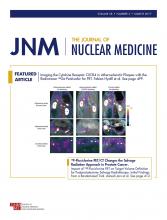Research ArticleImaging/Infection
Evaluation of Spleen Glucose Metabolism Using 18F-FDG PET/CT in Patients with Febrile Autoimmune Disease
Sung Soo Ahn, Sang Hyun Hwang, Seung Min Jung, Sang-Won Lee, Yong-Beom Park, Mijin Yun and Jason Jungsik Song
Journal of Nuclear Medicine March 2017, 58 (3) 507-513; DOI: https://doi.org/10.2967/jnumed.116.180729
Sung Soo Ahn
1Division of Rheumatology, Department of Internal Medicine, Yonsei University College of Medicine, Seoul, South Korea; and
Sang Hyun Hwang
2Department of Nuclear Medicine, Severance Hospital, Yonsei University College of Medicine, Seoul, South Korea
Seung Min Jung
1Division of Rheumatology, Department of Internal Medicine, Yonsei University College of Medicine, Seoul, South Korea; and
Sang-Won Lee
1Division of Rheumatology, Department of Internal Medicine, Yonsei University College of Medicine, Seoul, South Korea; and
Yong-Beom Park
1Division of Rheumatology, Department of Internal Medicine, Yonsei University College of Medicine, Seoul, South Korea; and
Mijin Yun
2Department of Nuclear Medicine, Severance Hospital, Yonsei University College of Medicine, Seoul, South Korea
Jason Jungsik Song
1Division of Rheumatology, Department of Internal Medicine, Yonsei University College of Medicine, Seoul, South Korea; and
In this issue
Journal of Nuclear Medicine
Vol. 58, Issue 3
March 1, 2017
Evaluation of Spleen Glucose Metabolism Using 18F-FDG PET/CT in Patients with Febrile Autoimmune Disease
Sung Soo Ahn, Sang Hyun Hwang, Seung Min Jung, Sang-Won Lee, Yong-Beom Park, Mijin Yun, Jason Jungsik Song
Journal of Nuclear Medicine Mar 2017, 58 (3) 507-513; DOI: 10.2967/jnumed.116.180729
Jump to section
Related Articles
Cited By...
- No citing articles found.







